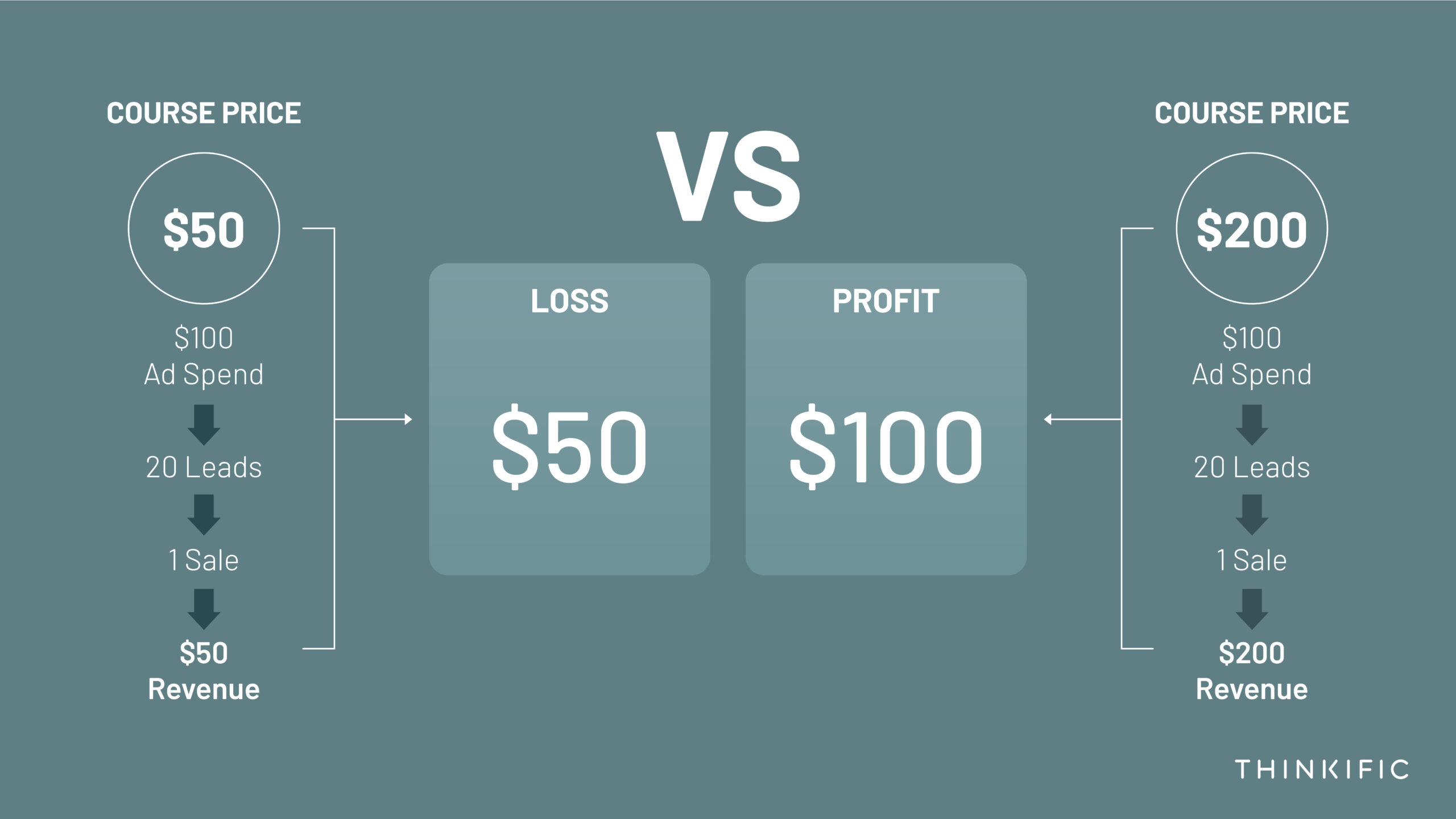In this day and age, knowledge is power, which is one of the reasons that the demand for online courses has continued to rise.
Whether you’ve already launched a course, or you’re about to, this guide will answer everything you need to know about selling online courses in just 7 easy steps.
Here’s what we’ll be covering if you want to skip ahead:
- Why create and sell an online course?
- How to sell online courses in 7 easy steps
Choose a topic for your online course - Research your online courses
- Outline your course goals and objectives
- Create your online course
- Price your online course
- Market and sell your online course
- Launch and refine your online course
Why create and sell online courses?
The number one reason to create and sell your online course is to share your expertise with the world. It also remains a profitable business format with the potential to increase your overall revenue and profit.
Additionally, an online course is a great way to create passive income. It’s also a fabulous way to expand your services into a global market no longer limited by geography or time zones.
Similarly, creating a successful online course can help you increase your brand awareness, create a loyal following and help position yourself as an expert in your industry.
Finally, imagine being able to work whenever you want from wherever you want. Building an online course can help you get there. All you need is some knowledge or expertise and the ability to talk about it with passion.
How to sell courses online in 7 easy steps
In this guide, we’ve simplified everything you need to know about how to sell online courses to help you grow your audience – and grow your revenue all in 7 easy steps.
1.Choose a topic for your online course.
Finding a topic is arguably the best part of designing an online course. If you already know your topic, you can move to the next step. But, if you find yourself struggling over what to create a course about, try asking yourself the following questions:
- What do you love to talk about?
- What do people come to you for advice on?
- Is there something you are passionate about or advocate for?
Once you know the answers to these questions, you can begin to brainstorm how to market and sell what you love into an online course. However, remember, no matter what topic you choose; it should be one that gets you excited.
2. Research your course subject matter.
Once you know your course topic, it’s time to research it. You can do this by looking at other online courses centred around the same subject. Additionally, if you’re part of a professional association, you can look to them to see the conversations people are having around your course topic.
In addition, it’s important to take the time to look at what your competitors are offering and to determine how you can differentiate. Finally, take time to brainstorm as many subcategories as possible to make building your online course that much easier.
3. Outline your online course’s goals and objectives.
Next comes the fun part; it’s time to outline your course’s goals and objectives. You can start this process by looking at all your subtopics and deciding what order you would each about them in to meet your bigger objective.
Then, ask yourself, what are the big takeaways you want people to get from each subtopic? Is there any guest speaker who might help you make your message even more impactful?
Finally, consider whether you’ll ask your students to follow the material in a chronological order or if they can watch it in any order they choose.
Related: How to Set Training Objectives to Help Students Reach Their Goals
4. Create your online course.
The next step is to create your course content. But first, it’s important to choose what online course platform you’ll use to do it. And while we might be biased, Thinkific makes it easy to build and organize your membership site and course with no technical expertise required.
Once you’ve chosen your platform, it’s time to film your content. To do this, be sure to set up a clean-looking space complete with proper lighting. Doing so will give your videos an authentic and professional feel. And remember, when filming, don’t forget to be yourself; people want to hear from you, we promise!
Related: How to create training videos
5. Price your online course.
Next it’s time to price your online course in a way that maximizes your profits.
The good news is, there are some simple strategies you can use for pricing your course and avoid one of the most common pitfalls to selling online courses – pricing them too low.
Here are a few things to keep in mind:
Price your course based on the value of the content.
The secret to selling online courses is to think about your course as the solution to a problem. This principle applies for pricing your course too.
Don’t price your course based on the length or complexity of the course, price it based on the value of your content. It doesn’t matter how long it takes students to complete the course, what matters is the results you deliver as quickly and efficiently as possible.
Don’t undersell your course.
The biggest mistake course creators make is pricing their online courses too low.
There’s an assumption that the lower the cost, the more courses you’ll sell. But pricing your course too low can actually damage your business long-term.

Although it’s tempting to price your course lower in order to sell more, you could be doing more harm than good. If you want to learn how to sell online courses, try to have the confidence to price your course higher.
We recommend selling online courses at a minimum of $50 and ideally pricing your course at $199 or more.
Consider pricing tiers.
If you’re not ready to price your course as a premium product, then consider offering pricing tiers instead.
Pricing tiers satisfy your buyers’ need to consider and compare different options, without the need to look at your competitors’ courses.
For example, you could have 3 pricing tiers with the most basic package at the lowest price point. The medium package will be your core course and the one the majority of buyers will opt for. The premium package might include exclusive features such as one-to-one or group coaching or live teaching elements.
With pricing tiers, you can make your course more accessible to a wider range of customers without reducing the perceived value of your expertise.
Whichever pricing strategy you use, remember that you can always adjust it as you go. As you get more customers and your course develops, increase the price accordingly. This lets you charge more as you refine your marketing and add value to the course.
6. Market and sell your online course.
When it comes to selling online courses, it’s important to learn some basic marketing strategies to help you reach your target audience and convince them to make a purchase.
There’s a huge number of ways you can market your online course – but there are some easy methods you can use to sell online courses right away, whatever your industry or niche.
Consider using AI to help augment your course marketing strategies.
Here are some of the top marketing strategies for selling online courses:
Content marketing
Content marketing is the bread and butter of a course creator’s marketing strategy.
Content marketing encompasses any type of content you create for your business, be it blog content, video content, email content and more.
As a strategy to sell online courses, content marketing works to educate your audience and raise brand awareness. If you can produce valuable content for your audience, they will continue to engage with your brand and are more likely to convert into customers down the line.
Content marketing also helps to:
- Improve your brand reputation
- Increase referral traffic
- Boost your search engine visibility
- Build a closer relationship with customers
The secret to using content marketing for your business is to target your audience through the channels and platforms they use the most.
Find out where your target audience likes to spend their time online and use this to shape your content marketing strategy.
For example, if you have a sourdough bread course for beginners, you could produce YouTube video tutorials on different bread-baking techniques and have a recipe blog with downloadable guides and checklists.
In every piece of content, you produce, you can include a Call-To-Action (CTA) to visit the landing page for your online course.
Email marketing
If you want to upsell past customers, or nurture leads that aren’t ready to purchase yet, email marketing is another really handy marketing strategy to have up your sleeve.
Email marketing lets you reach your target audience through a series of emails designed to introduce customers to your brand, offer them valuable resources and move them through your sales funnel.
If you can build your email list, you’ll have a direct link to potential customers to engage with them regularly, building trust over time.
With email marketing, you can also:
- Provide a more personalized service to customers
- Offer product recommendations
- Collect customer feedback through surveys
- Drive traffic to your website
- Add value for your audience
Filling your funnel with lead magnets
To start building your email list, work on creating lead magnets that will encourage your audience to share their email address with you.
Some ideas for top-converting lead magnets include:
- Free mini-courses
- Downloadable guides
- Webinars and events
Find more ultra-effective lead magnet ideas here.
Once you’ve built an email list, the trick is to retain those subscribers. That means producing emails that provide genuine value to your audience with plenty of tips and useful resources.
Learn more about how to leverage email marketing to sell online courses in our full-length guide.
Social media marketing
Nowadays, if you want to learn how to sell online courses, you need to learn how to use social media marketing to your advantage.
Social media is a highly effective tool for selling online courses thanks to its power to get your brand in front of the right people extra fast.
With the right social media campaign, your brand awareness can skyrocket overnight.
Your social media success depends a lot on your strategy, including:
- What you post – and whether it’s valuable or interesting to your target audience
- How you present your brand – including your brand voice, imagery and content style
- How you engage with other accounts – including with customers, influencers and other brands
- How you create a community around your brand – by making your audience feel seen and heard
Like all your marketing efforts, your social media should aim to represent your brand in the best possible way and show off your brand personality. Think about the face you’re presenting to your audience – and if it will appeal to your ideal customer and help you sell online courses.
Get our complete guide to social media marketing to sell online courses here.
Influencer marketing
To help you sell online courses on social media, use Influencer Marketing to your advantage. Connect with likeminded influencers on social media and use them to bring your brand to a wider audience.
Getting started with influencer marketing is easy – check out the profiles of influencers in your niche who fit with your brand values. Then simply drop them a private message and introduce yourself.
Influencer collaborations can be paid or free and they can include:
- Branded or sponsored posts
- Guest posts
- Social media takeovers
- Re-sharing or brand shout outs
By partnering with influencers in your niche, you can boost customer trust in your brand and bring your brand to a wider audience.
For more tips on how to do influencer marketing as a first-timer and create an influencer marketing strategy, check out this guide.
Three simple tips for better brand marketing
Look at the big picture.
If you’re using marketing to sell online courses, it’s a really good idea to create a cohesive marketing strategy across multiple marketing channels.
Instead of running different campaigns via email, social media and on your website, aim to make all your marketing channels work together and compliment one another.
The messages you share on one platform should be echoed across every channel – this not only helps to create a cohesive brand image for customers, it also makes it easier for you to repurpose and recycle content.
To go back to the sourdough bread example – you might choose to run a campaign on making sourdough starters with white flour, wholewheat and rye. You could create a series of video tutorials on YouTube, run Reels on Instagram and write weekly email newsletters focussing on each type of starter with downloadable guides.
Customers can find your content via the channel they use the most and get a clear picture of exactly what your brand offers and how you can help them.
This is the same content and knowledge used in different ways – and it all adds up to establishing your authority as a sourdough expert for your audience.
To learn how to create a comprehensive content marketing strategy, find our full guide here.
Write compelling copy.
Any marketing content you create needs to catch your audience’s attention to help you sell your products.
That means you need to learn how to write compelling, persuasive copy that drives your audience to take action – such as signing up for your newsletter, sharing with a friend or buying your online course!
Thankfully there are some tips and tricks you can use to write engaging copy and sell online courses – check out our guide to learn how to write sales copy that sells.
Use social proof.
Remember that your buyers are only human – so it’s normal if they’re unsure about whether or not to make a purchase from a brand they don’t know.
To help ease their fears and convince them you’re the right choice, you can leverage social proof. Social proof is a really useful method to leverage trust to help you sell more.
Social proof includes:
- Testimonials and reviews
- Customer interviews
- Case studies
- Statistics e.g. the number of people you’ve helped
- Brand logos and accreditations
By showing off your previous happy customers, you can convince buyers to make a purchase from you.
Social proof also leverages the fear of missing out or FOMO effect. If everyone else is buying and loving your products, then the rest of your audience will want to get involved too!
Use social proof on your landing pages, your social media, email marketing and more.
Related: using social proof to sell online courses.
7.Launch and refine your online course.
The most successful course creators – who also sell the most courses – follow a cyclical process of launching their online courses, and continually improving them.
Also known as a feedback loop, this process of (re)launching and refining is all about listening to customer feedback and using it to refine your course content.
The process goes like this:
- Listen: Ask your customers for feedback to understand what they want from your course
- Sell: Refine your offer using customer feedback and use it to create something that’s irresistible to your audience
- Create: Tailor your course content according to customer feedback to create a professional, beneficial learning experience for customers
- Launch: Launch your course and run it with real students to deliver on your pre-sell promise, then restart the loop to refine your offering and your course.
This circle of gathering feedback and refining your offering and content lets you improve your course content over time, shaping it into the ideal product for your audience.
It starts with pre-selling your online course but then it continues even after your course has launched – this means you keep adding to and refining your offer and your course content according to customer feedback, letting you create the best possible course on the market.
Here are some of the benefits of creating feedback loops:
- Find out what your customers really think
- Engage customers to help them feel valued and listened to
- Increase customer retention
- Refine your product for your target audience
- Tailor your messaging to reach your audience
- Listen to your customers to learn how to sell online courses to your target audience – they are the best advisors you have!
(Check out Thinkific millionaire Ellie Diop’s proven tips on how to make the most of feedback loops.)
For best effects, create opportunities for feedback at the end of every module. Include a survey that lets students share their opinions, ideas, and any complaints. You can also schedule one-to-one calls with a select number of students for more in-depth feedback.
If you have an online learning community, use this space to gather more feedback from students – post open-ended questions, surveys, and polls to get as much data as possible on how to improve your course
Sell Online Courses with Thinkific
There you have it – these are the major milestones in selling your online course! Hopefully, these 7 steps give you a good idea of what you should focus on.
This blog was updated in October 2023. It was originally published in 2022.





